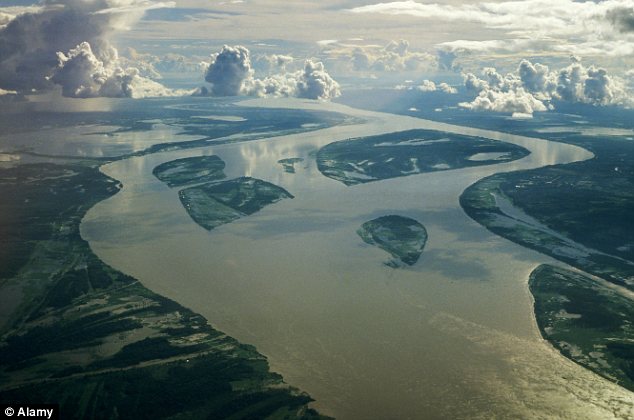[bor-tar-nay]
1. Overview
Bor’Tarnay marks the lush meeting point of Vahshi Forest’s rainforest and the ocean, forming an expansive delta where countless rivers converge. This ecologically rich area is not only a hotspot for biodiversity but also a critical economic zone, where mortal settlements capitalize on the fertile floodplains and abundant fishing opportunities.

2. Geography
The Bor’Tarnay delta is characterized by its vast waterways and fertile lands, stretching far beyond the visible horizon into a misty expanse. These waterways, fed by the dense rainforest upstream, create a network of channels that are both a lifeline for local communities and a natural pathway deep into the heart of the Vahshi Forest. The delta’s geography, with its extensive floodplains and nutrient-rich sediment, supports diverse agricultural activities and provides a crucial habitat for aquatic life.
3. History
Historically, Bor’Tarnay has been a gateway between the ocean and the dense interiors of the Vahshi Forest. The delta has seen the rise of vibrant communities that have thrived by harnessing the natural resources around them. Over time, these settlements have become integral in managing the delicate balance of ecological preservation and economic development, evolving into crucial hubs for trade and cultural exchange between the forest dwellers and the outside world.
4. Political Structure
The political structure of Bor’Tarnay is notably diverse, reflecting the variety of towns and different species that inhabit this fertile delta. Governance varies significantly across the region, with each settlement developing its own system based on local needs, traditions, and the demographic makeup of its inhabitants. Some communities may be governed by elected councils, others by influential family clans, or even cooperative guilds of fishermen and farmers.
5. Economy
The economy of Bor’Tarnay is driven by agriculture and fishing, exploiting the fertile delta soil and abundant fish stocks. Crops grown here—benefiting from the rich sediment—are bountiful, serving both local consumption and trade with neighboring regions. Fishing, particularly, is a vital industry, with local fishermen renowned for their expertise in navigating the delta’s complex waterways to harvest the rich marine life.
6. Culture and Society
Bor’Tarnay’s culture is as varied as its landscape, deeply influenced by the neighboring Vahshi Forest and its inhabitants’ profound connection to nature and the deity Alber. Across the delta, communities integrate elements of nature worship into their daily lives, which is manifested in their environmental practices, agricultural methods, and seasonal festivals. These practices often center around respecting the natural world, with rituals and traditions that emphasize harmony and sustainability.
However, the integration of divine worship into daily life presents a cultural clash with the more secular traditions prevalent across Kair’Thear. This divergence leads to occasional tensions, as traditionalists struggle to reconcile these spiritual practices with the broader regional ethos that favors secularism. Despite these challenges, many inhabitants of Bor’Tarnay continue to celebrate their spiritual heritage.
7. Military
Bor’Tarnay lacks a formal military presence but maintains a militia capable of defending the delta’s resources. The community relies on its knowledge of the local terrain and waterways to protect against external threats and to ensure the ecological integrity of the area is preserved.
8. Notable Locations
- Cadura: The capital city of Bor’Tarnay, located on the edge of the Vahshi Forest and the vast Delta. It has long stood as the crossing point, culturally, economically and physically of the Vahshi forest and the wider world.
- Avanpost: A Riben outpost city, it has seen significant growth in recent years, and teeters on the edge of becoming to dominant city within Bor’Tarnay. It’s recent growth and bullying tactics have not made it a popular location with other Bor’Tarnay residents.
- Mangrove Cathedral: Located on an island in the vast delta area, the Mangrove Cathedral is a naturally formed network of mangrove roots and trunks so dense and expansive that it resembles the vaulted ceiling of a massive cathedral. It has become a significant place of worship for a range of nature bound deities, from Alber to needs name still
9. Significant Characters
10. Current Issues and Future Prospects
Bor’Tarnay faces significant environmental and political challenges, particularly from the expansionist ambitions of Riben to its west. Riben’s aggressive territorial growth poses a direct threat to Bor’Tarnay’s delicate ecological balance and its culturally diverse communities. There is a widespread concern among the inhabitants that Riben’s differing beliefs and lack of environmental reverence could lead to devastating impacts on the delta’s ecosystem, which is central to the region’s economy and way of life.
The prospect of Riben’s influence extends beyond mere territorial expansion; it threatens the very cultural and spiritual fabric of Bor’Tarnay, potentially disrupting centuries-old traditions and practices linked to nature worship and ecological stewardship. In response, local leaders and communities are rallying to fortify their cultural identity and prepare for potential conflicts, both ideological and physical.